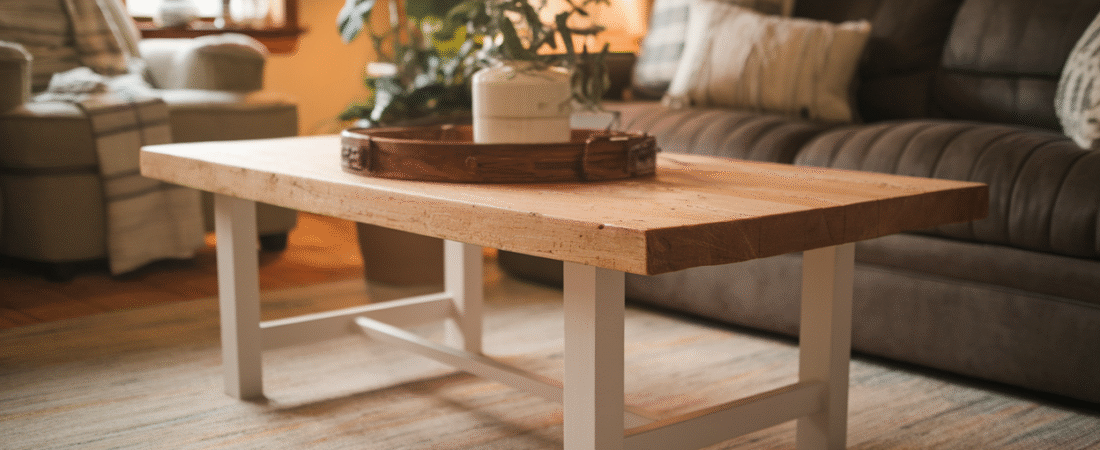DIY farmhouse coffee table projects are among the most rewarding woodworking tasks you can take on, blending rustic charm with practical functionality. This comprehensive guide walks you through everything from choosing the right wood to downloading farmhouse coffee table plans PDF files and building your very own masterpiece.
At ChicHaven, we believe every home deserves a touch of elegance. That’s why our blog is packed with inspiring ideas and helpful tips to make your home uniquely yours. You can learn more about our passion and journey on our About page.
By the end of this article, you’ll not only know how to build a simple DIY farmhouse coffee table but also gain access to free plans, design inspirations, and pro tips to perfect your project.
Table of Contents
Table of Contents
Understanding the DIY Farmhouse Coffee Table Basics
What Makes a Farmhouse Coffee Table Unique?
A farmhouse coffee table stands out because it embodies a rustic, lived-in charm while remaining highly functional. Unlike modern glass tables, these pieces use solid wood, often with distressed finishes or visible grain patterns. The design typically features sturdy legs, a spacious tabletop, and sometimes storage solutions like drawers or lower shelves. The rustic style effortlessly complements various decor themes, from traditional country to industrial chic. For anyone seeking warmth and character in their living room, a farmhouse coffee table is an ideal choice.
Benefits of Building Your Own Coffee Table
Building your own coffee table allows you to control every aspect of its design and construction. You can choose the dimensions, materials, and finish that perfectly match your home’s aesthetic. Additionally, a DIY approach often costs less than buying a high-quality table from a store. Most importantly, the satisfaction of crafting something with your own hands cannot be overstated. The process also allows you to learn new skills, whether you’re cutting wood for the first time or perfecting your finishing techniques.
Choosing the Right Materials for Your Project
Best Woods for Farmhouse Coffee Tables
Selecting the right wood is critical for achieving both durability and beauty. Hardwoods like oak, maple, and walnut are excellent choices because they stand up to daily wear and tear while providing rich textures. Softwoods such as pine are more affordable and easier to work with, making them perfect for beginners. Reclaimed wood is another great option if you’re aiming for an authentic, weathered farmhouse look. This not only adds character but also supports eco-friendly practices.
How to Make a Pine Coffee Table Effectively
Pine remains a top pick for many DIY enthusiasts due to its lightweight and workable nature. To make a pine coffee table, start by cutting the boards to the desired size. Sand each piece thoroughly to ensure smooth edges and surfaces. Assemble the frame with wood glue and screws, reinforcing the joints for added stability. Once assembled, you can stain or paint the table to enhance its farmhouse appeal. Applying a sealant will protect it from spills and scratches. Don’t miss our modern TV wall unit ideas to complement your new table in your living room setup.
Essential Tools and Supplies You’ll Need
Must-Have Tools for DIY Projects
To successfully build a DIY farmhouse coffee table, you’ll need basic woodworking tools. These include a saw (circular or miter), drill, measuring tape, clamps, sander, and a square. Investing in quality tools ensures precision and makes the entire process smoother. Safety gear like goggles, gloves, and ear protection is also essential to prevent accidents.
Additional Supplies for Finishing Touches
Beyond the tools, gather supplies such as wood glue, screws, nails, stain, paint, and a protective finish. Using quality finishing products will enhance the table’s longevity and appearance. For added charm, consider decorative hardware like rustic handles or metal brackets. Discover great ideas like cozy reading nook setups to create a cohesive and inviting living space around your new table.
Step-by-Step Guide to Building a DIY Farmhouse Coffee Table
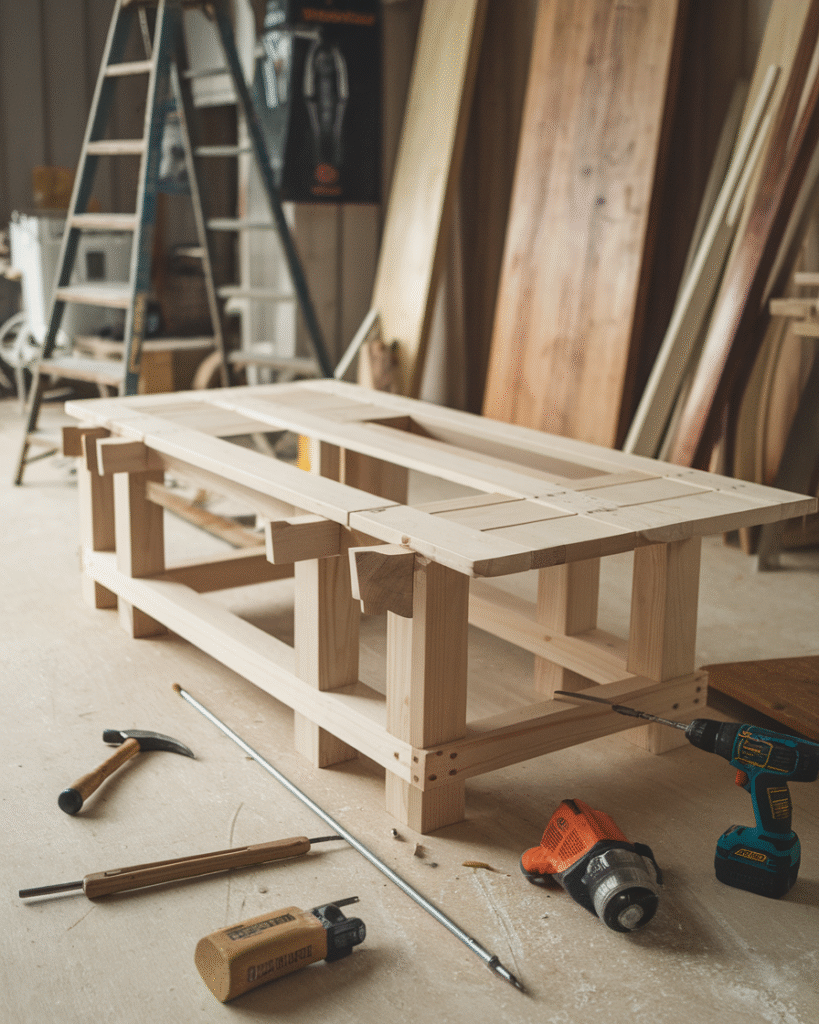
Simple DIY Farmhouse Coffee Table Construction Steps
- Plan and Measure: Use DIY farmhouse coffee table plans free of charge to outline exact dimensions.
- Cut the Wood: Prepare your tabletop, legs, and lower shelf if desired.
- Assemble the Base: Attach legs to the frame using screws and glue for stability.
- Secure the Tabletop: Place and fix the top onto the frame, ensuring alignment.
- Sand Smoothly: Smooth all surfaces and edges to avoid splinters.
- Stain or Paint: Apply your chosen finish for that rustic farmhouse vibe.
- Seal for Protection: A polyurethane coat will keep it durable against daily use.
Common Mistakes to Avoid During Assembly
Many DIYers rush through measurements, resulting in misaligned parts. Always double-check before cutting. Using low-quality screws or insufficient glue can weaken the structure, so invest in durable materials. Avoid skipping the sanding stage, as rough edges detract from the final look. Lastly, don’t forget to allow each finish layer to dry completely before moving to the next step. For added decor harmony, check out brilliant living room lighting ideas that can highlight your table’s beauty.
Exploring Farmhouse Coffee Table Plans
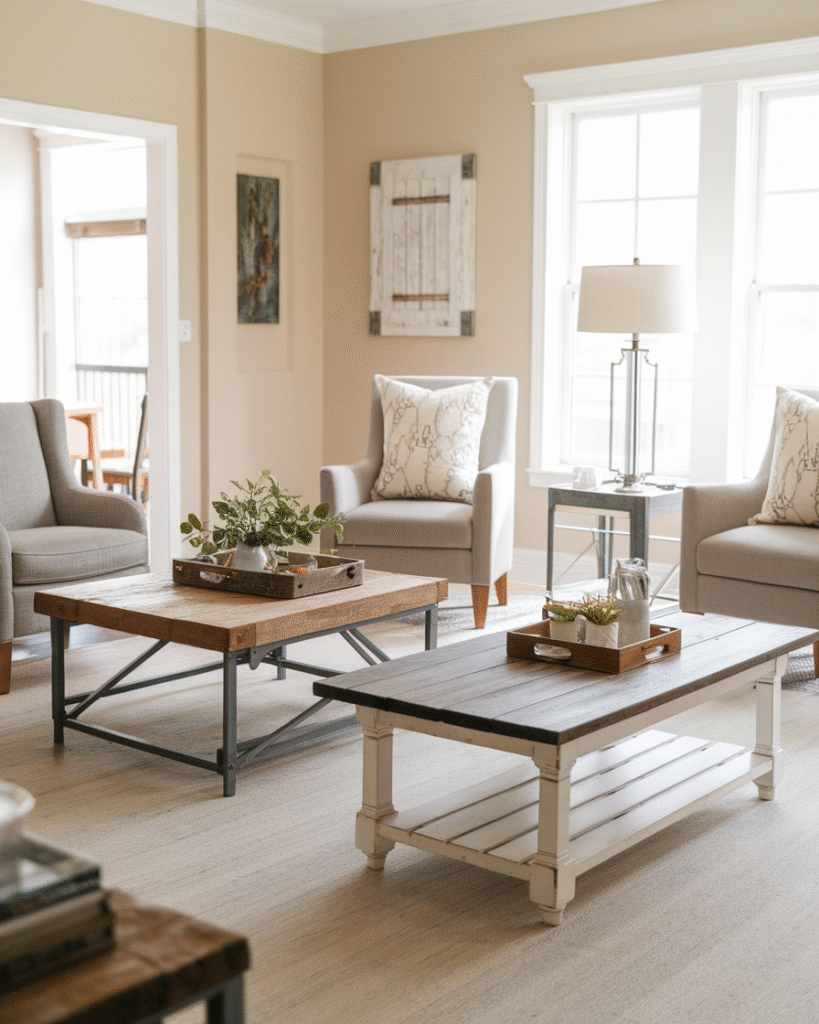
Where to Find Farmhouse Coffee Table Plans Free Downloads
If you’re eager to start your project with a solid guide, there are many sources offering farmhouse coffee table plans free. These plans simplify the process by providing clear diagrams, material lists, and cutting instructions. You can easily adapt them to fit your desired size or style. Websites like Naomi Home offer step-by-step ideas perfect for beginners and experienced DIYers alike. With these resources, building a sturdy and stylish table becomes a straightforward process.
How to Use a Farmhouse Coffee Table Plans PDF for Accuracy
Using a farmhouse coffee table plans PDF ensures that every measurement is precise, reducing the risk of errors during construction. Print out the plans and keep them handy while working, marking off each completed step. PDFs often come with detailed illustrations, making it easier to visualize the final product. For more guidance, check out Handmade Haven, which provides chunky farmhouse coffee table designs with comprehensive instructions. You may also find useful build plans on 731 Woodworks, where skilled craftsmen share their expertise. Combining these resources will help you create a flawless piece that stands out in your living room.
10 Popular Designs Every Home Decor Blog Uses
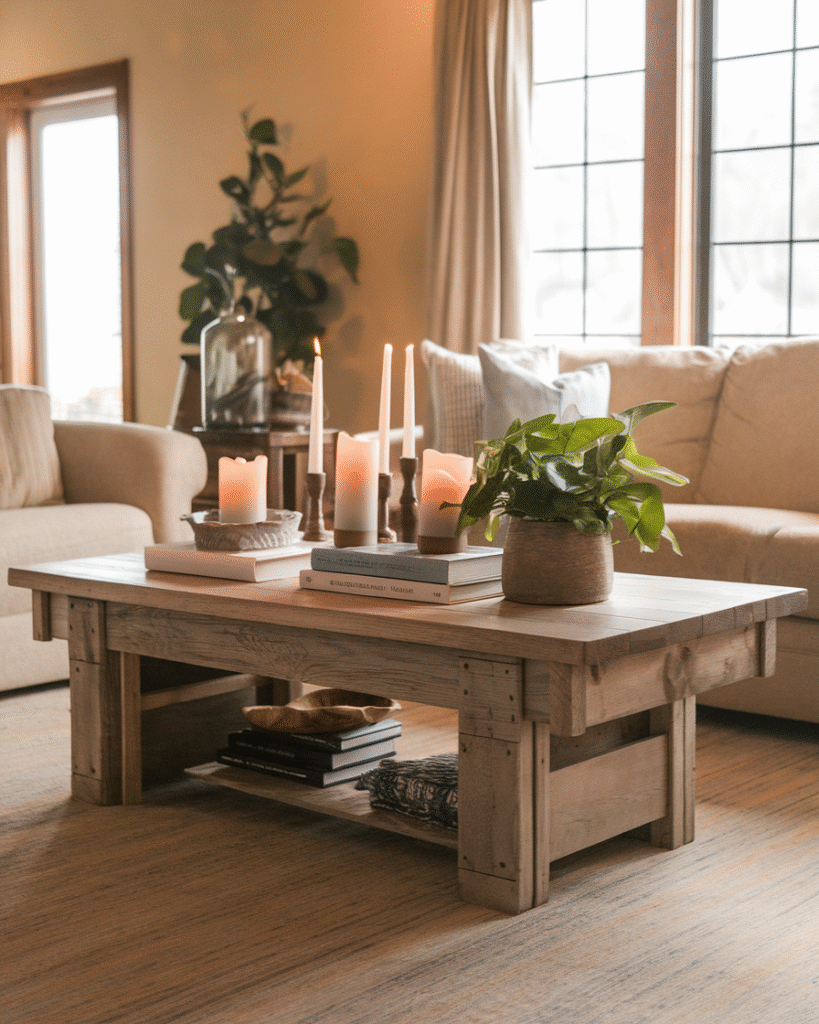
When it comes to creating a DIY farmhouse coffee table, choosing the right design is crucial. Below are ten trending styles that every home decor blog swears by. Each design offers a unique charm, giving you plenty of inspiration to pick the one that suits your space and style.
1. Rustic X-Frame Coffee Table
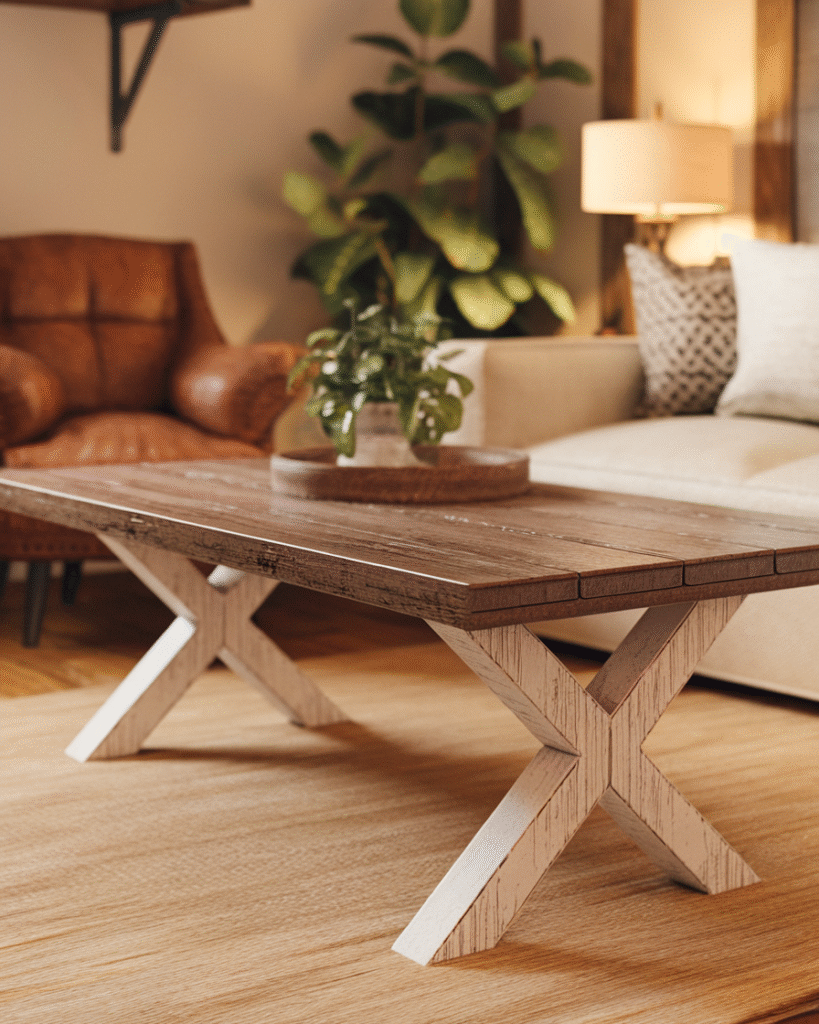
The Rustic X-Frame design stands out with its bold “X” side supports, giving the table a strong, farmhouse character. For this build, use distressed wood for the tabletop to highlight natural imperfections. The legs can be painted white to create a classic rustic vibe that pairs beautifully with country-style interiors. This style is ideal for those who want a sturdy and visually striking DIY farmhouse coffee table that can anchor the room effortlessly.
2. Barnwood Plank Coffee Table
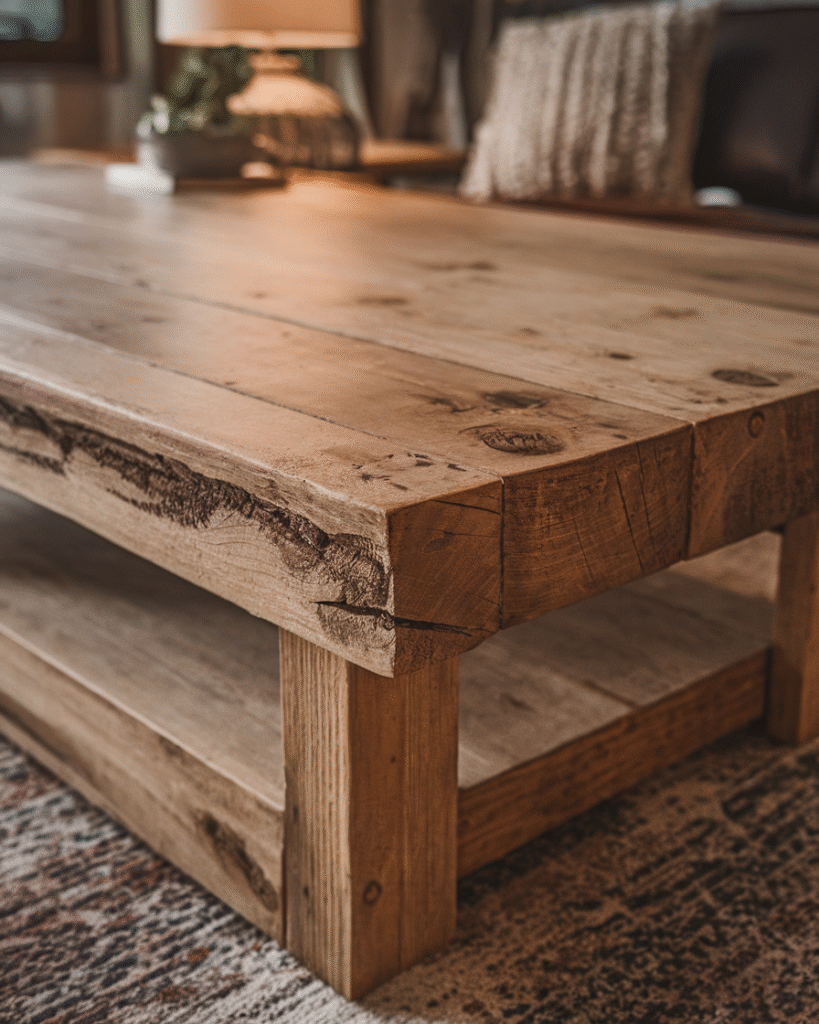
For an authentic farmhouse touch, the Barnwood Plank Coffee Table uses reclaimed barn wood. The beauty of this design lies in its imperfections—knots, cracks, and grain variations add personality. Applying a clear matte finish will enhance and protect the wood while preserving its raw beauty. This is a great project if you love sustainability and want a one-of-a-kind piece for your living room.
3. Industrial Farmhouse Style
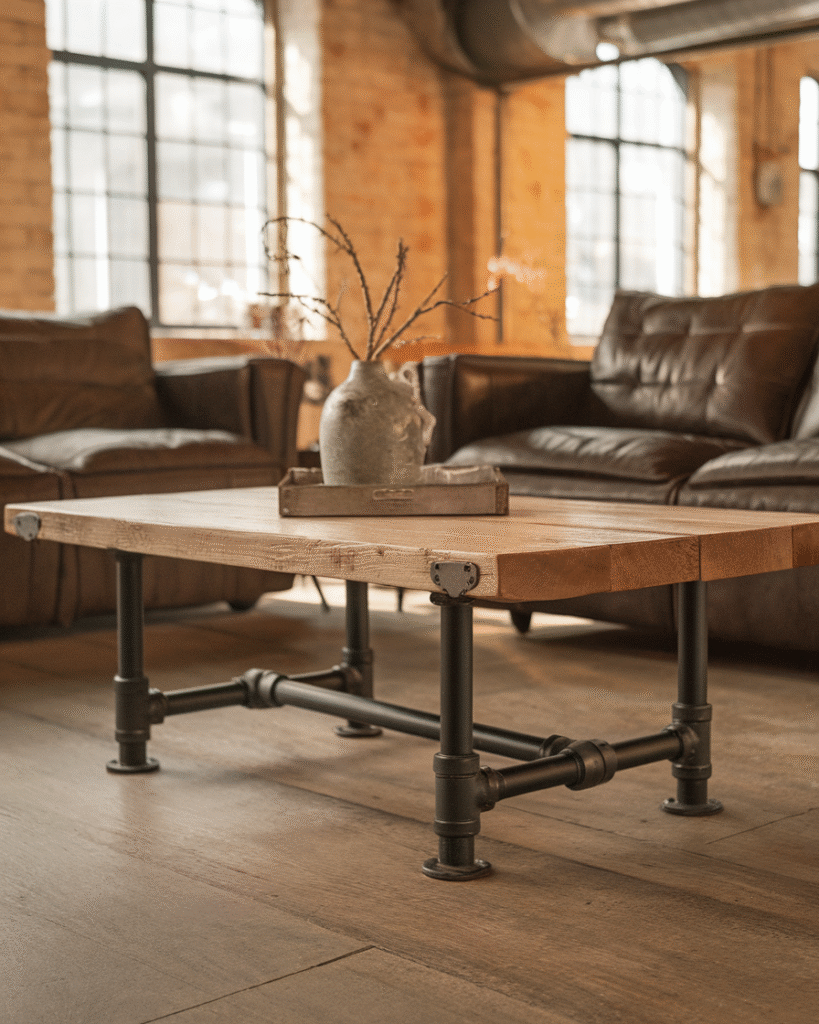
Mixing wood and metal brings an edgy yet rustic appeal. The Industrial Farmhouse Style coffee table pairs a wooden top with metal pipe legs or black iron brackets. This combination not only adds strength but also creates a chic industrial farmhouse vibe. It’s perfect for modern spaces that still crave the warmth of farmhouse decor.
4. Lift-Top Storage Coffee Table
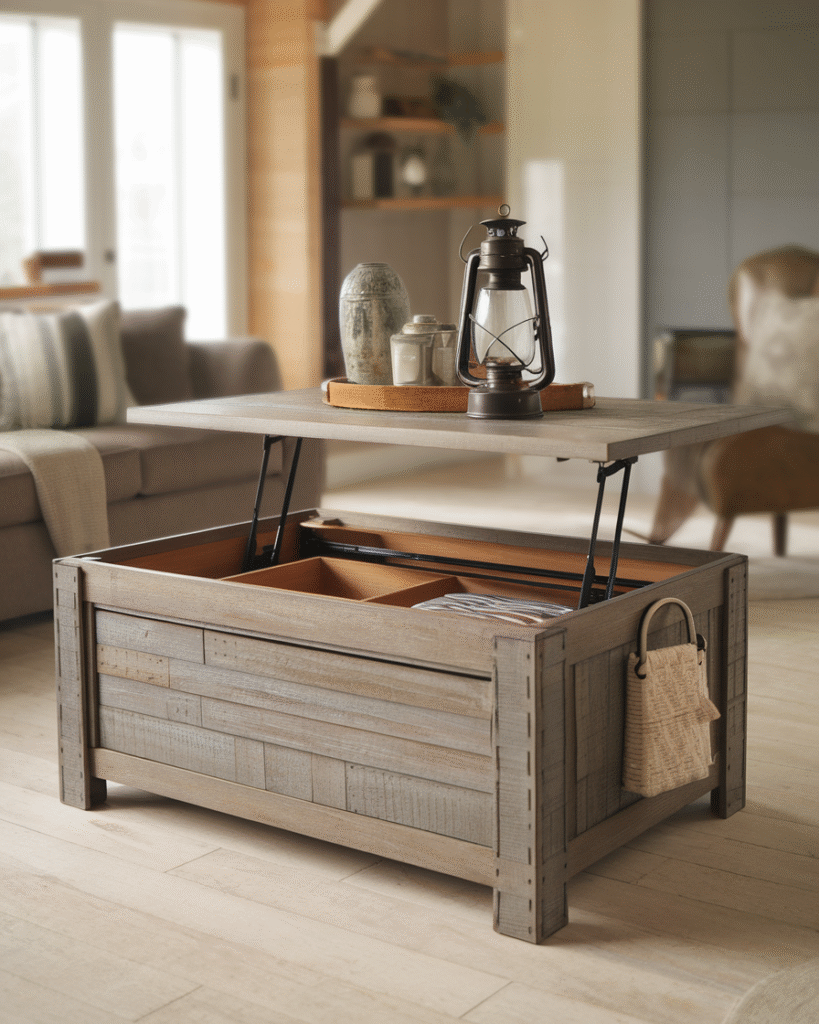
A Lift-Top Storage Coffee Table combines style with functionality. The lift-top mechanism allows for hidden storage, perfect for small living rooms where space is limited. Using shiplap or weathered wood for the surface keeps the farmhouse look intact. This design is great for storing remotes, books, and other essentials while maintaining a clean surface.
5. Two-Tier Farmhouse Coffee Table
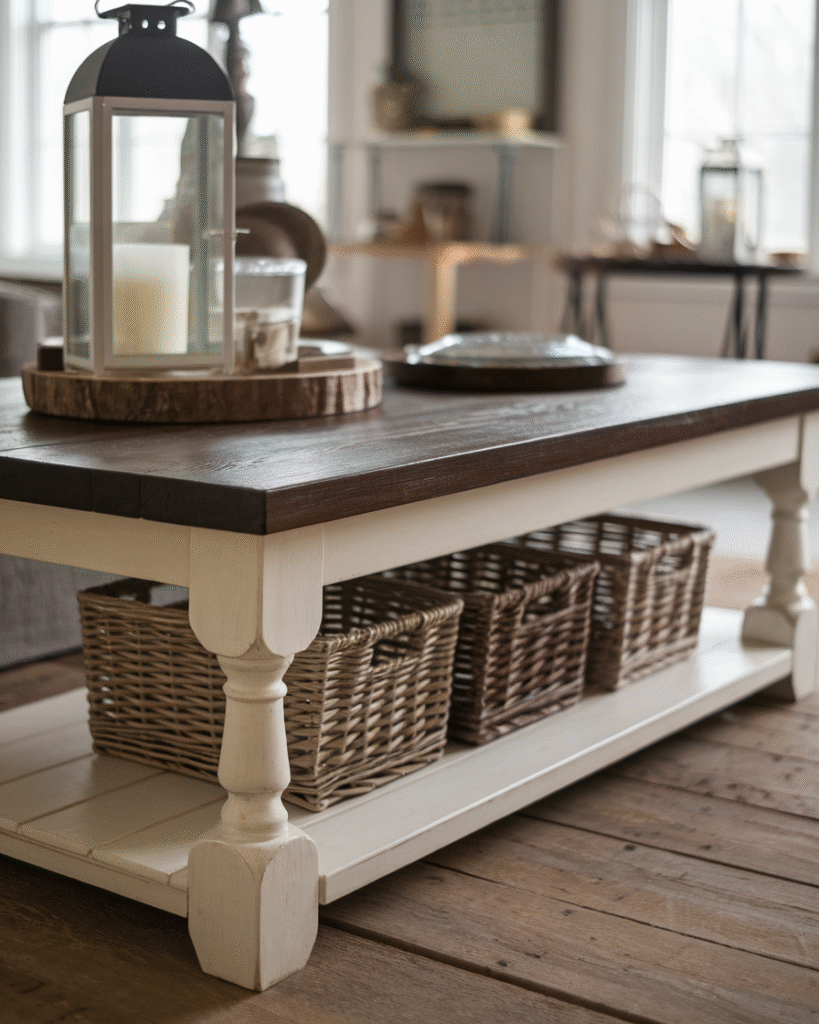
This design offers extra storage with a lower shelf that’s perfect for baskets, décor items, or books. Stain the top in a rich, dark tone while painting the base white to create a beautiful contrast. The Two-Tier Farmhouse Coffee Table is a practical and elegant choice that works well in busy households.
6. Pallet Wood Coffee Table
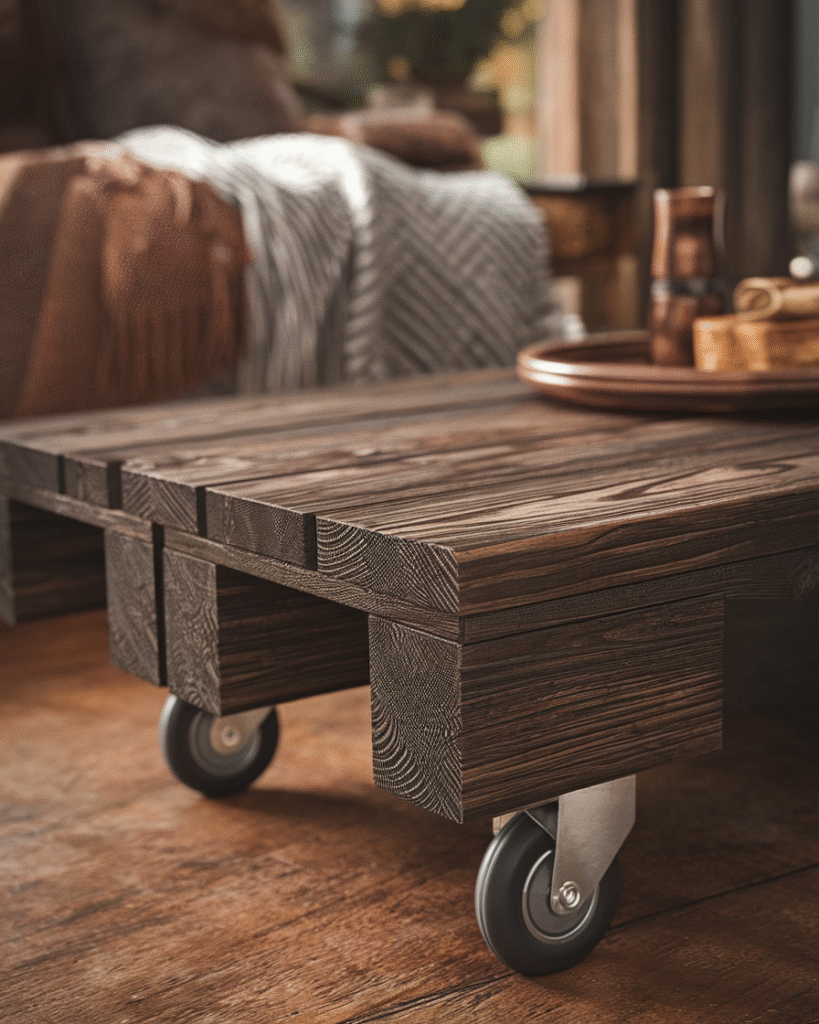
The Pallet Wood Coffee Table is an eco-friendly and budget-friendly project. Using reclaimed wooden pallets, you can craft a charming farmhouse table that’s full of character. Sand the wood thoroughly to remove rough edges, then stain it to enhance the grain. Adding caster wheels gives it mobility, making it versatile for different room arrangements.
7. Crate-Style Coffee Table
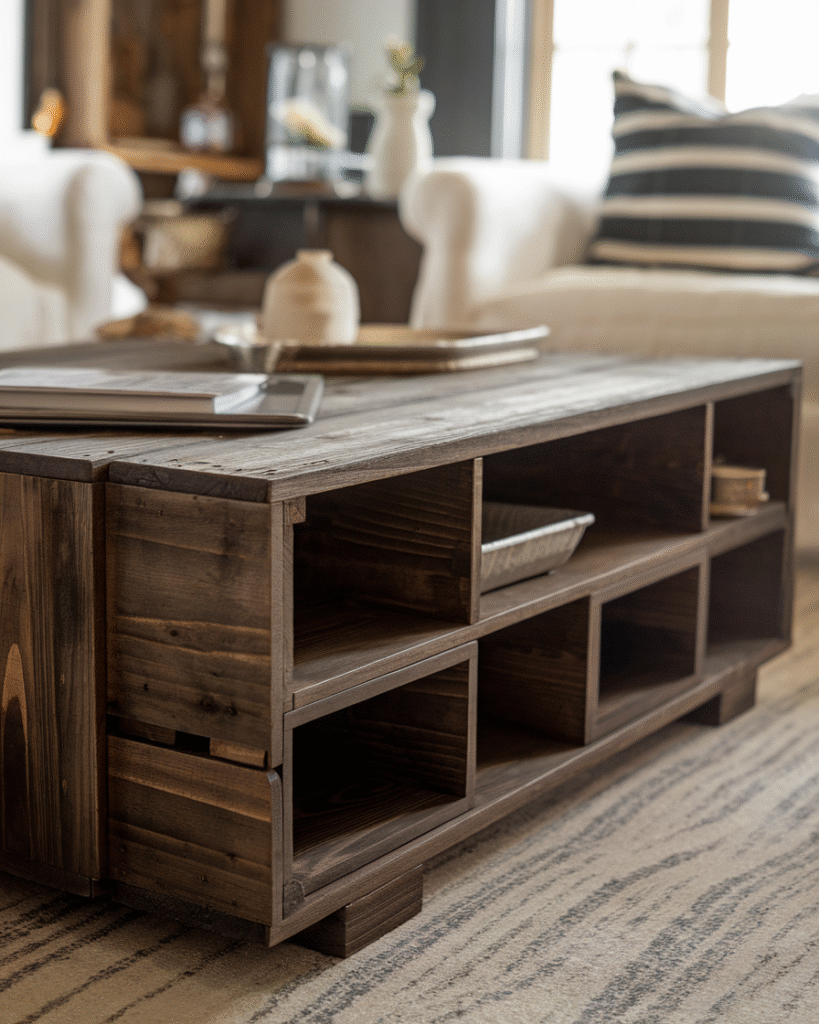
This design uses wooden crates arranged to form a table with built-in cubbies. The Crate-Style Coffee Table offers extra storage while showcasing a rustic farmhouse character. It’s ideal for storing magazines, blankets, or small decorative items. With a dark stain and a protective finish, this table can become a focal point in any living room.
8. Round Farmhouse Coffee Table
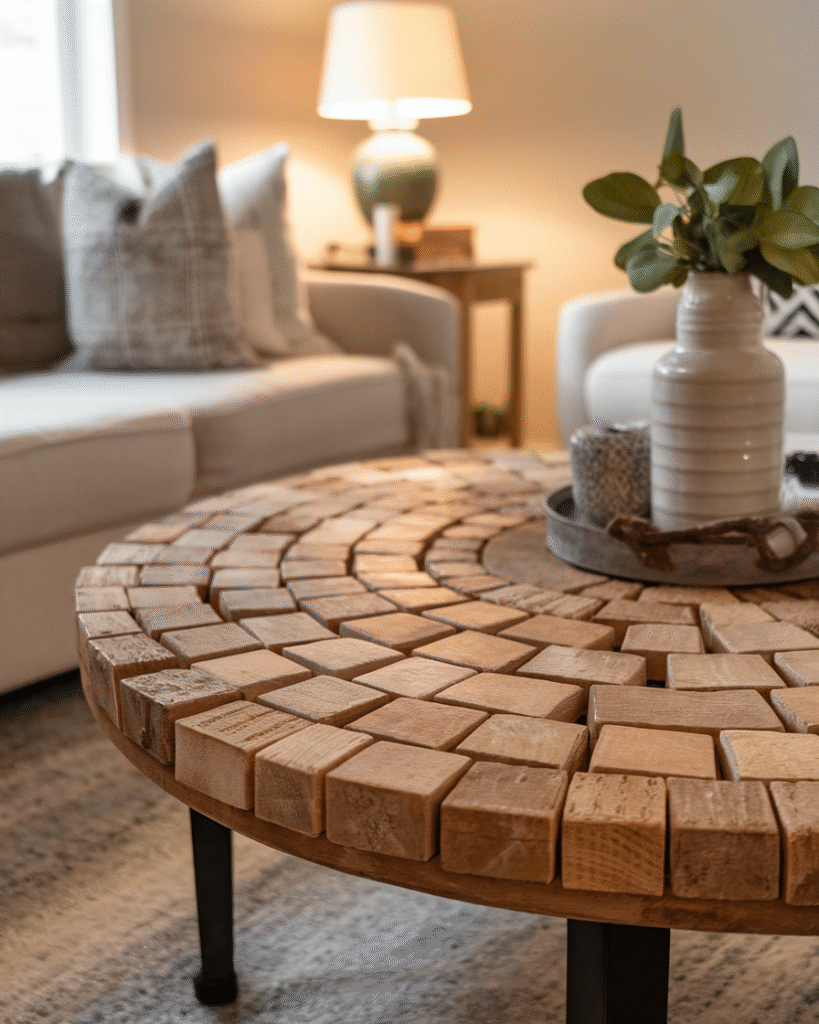
A Round Farmhouse Coffee Table softens the edges of a room while keeping the rustic aesthetic intact. Use reclaimed wood planks arranged in a circular pattern for a unique visual effect. This design works exceptionally well in smaller spaces where a rectangular table might feel too bulky. Pair it with cozy rugs and soft furnishings for a balanced farmhouse look.
9. Whitewashed Farmhouse Coffee Table
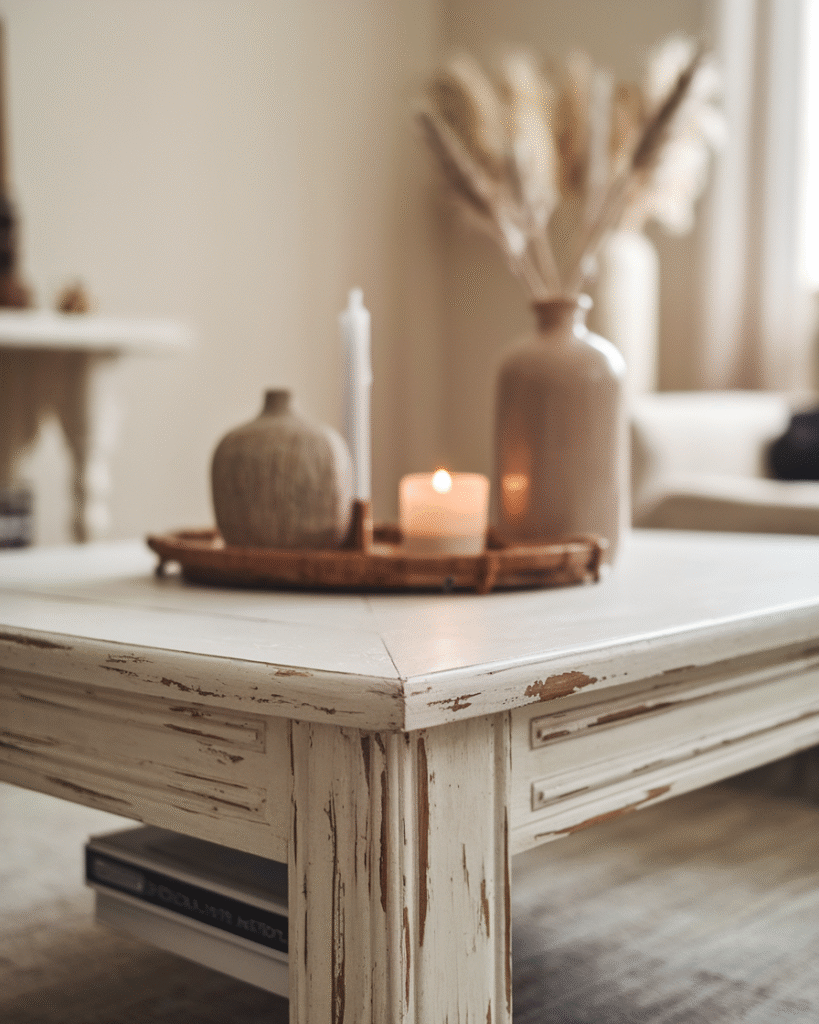
For a cozy cottage-style vibe, the Whitewashed Farmhouse Coffee Table is a top choice. Apply a whitewash finish to a wooden table to achieve a vintage, weathered look. This design pairs wonderfully with neutral décor and creates an airy, inviting ambiance. It’s simple yet full of charm, making it a favorite among DIYers.
10. Vintage Trunk Coffee Table
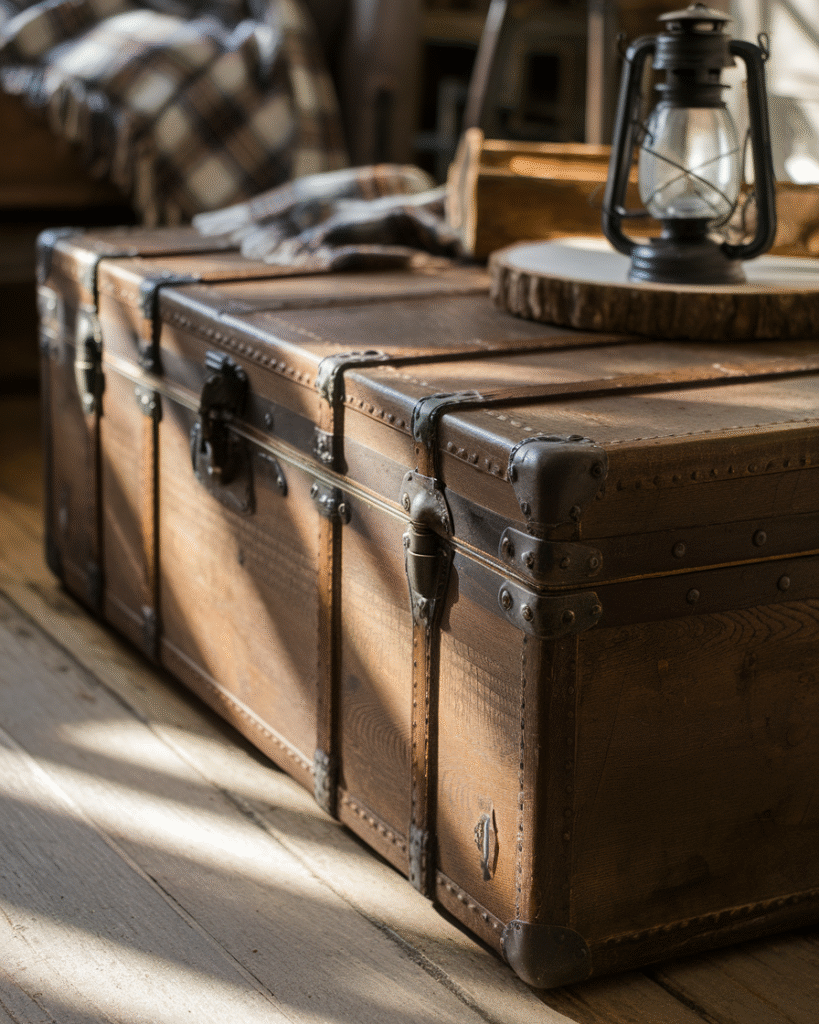
Repurposing an old wooden trunk into a coffee table is a brilliant way to add nostalgia and farmhouse charm to your living room. The trunk doubles as storage, keeping your space tidy while adding a conversation piece. Sand and refinish the wood to revive its character while maintaining its vintage appeal. This design offers both functionality and style, perfect for farmhouse lovers.
These ten designs are not only beginner-friendly but also budget-conscious, ensuring anyone can bring farmhouse style into their home without spending a fortune. Each DIY farmhouse coffee table design can be customized with different finishes, stains, or hardware to match your unique taste.
Styling and Decorating Your Farmhouse Coffee Table
Accessories That Complement Farmhouse Style
Once your DIY farmhouse coffee table is built, styling it is the next step to enhance its charm. Farmhouse decor thrives on a mix of textures and natural elements. Start with a centerpiece, like a wooden tray or woven basket, to organize small items. Add greenery with a simple potted plant or mason jar filled with flowers. Incorporate candles, books, or rustic lanterns to create layers of interest. A soft linen runner or burlap cloth can also bring warmth and texture to the table’s surface.
Tips for Seasonal Table Decor
Seasonal decorations can keep your farmhouse coffee table looking fresh year-round. In spring, use pastel flowers and ceramic vases. Summer calls for vibrant accents like lemons in a bowl or nautical elements. For autumn, pumpkins, plaid throws, and amber candles add cozy warmth. During winter, small evergreen arrangements and warm-toned lights bring a festive touch. The key is to keep decor minimal to avoid clutter while still celebrating each season’s character.
Maintenance and Care for Your Farmhouse Coffee Table
Protecting Wood Surfaces Over Time
Taking proper care of your DIY farmhouse coffee table ensures it remains beautiful and functional for years. Start by applying a high-quality sealant right after building to protect the wood from moisture, scratches, and stains. Use coasters under drinks and placemats under decorative items to prevent rings and dents. If your table has a distressed or whitewashed finish, consider reapplying a protective coat every year to keep the look intact. Regular dusting with a soft cloth will also help maintain the table’s natural luster without scratching the surface.
Easy Cleaning Hacks for Long-Lasting Beauty
Cleaning a DIY farmhouse coffee table is simple if you follow the right techniques. Avoid harsh chemical cleaners, as they can strip the finish and damage the wood. Instead, use a mild soap mixed with warm water for routine cleaning. Wipe up spills immediately to prevent stains from setting in. For stubborn marks, gently rub them out with a mixture of baking soda and water. Polishing the table with a natural oil, such as mineral or linseed oil, will refresh its appearance and protect the wood grain. By maintaining it regularly, your table will stay as stunning as the day you built it.
Conclusion
Building a DIY farmhouse coffee table is more than just a woodworking project—it’s a way to bring rustic charm and a personal touch to your living room. A DIY farmhouse coffee table allows you to choose every detail, from the wood you use to the finish you apply, making it a custom piece that perfectly fits your home’s style. Whether you’re drawn to a rustic X-frame, a whitewashed surface, or even a vintage trunk conversion, there’s a DIY farmhouse coffee table design that will match your vision.
When planning your DIY farmhouse coffee table, selecting the right materials is crucial. Reclaimed wood, pine, or oak work beautifully for that authentic rustic feel. Many home decorators choose to enhance their DIY farmhouse coffee table with distressed finishes, giving it a cozy, lived-in character. Adding hardware like black metal brackets or wooden cross beams can make your DIY farmhouse coffee table stand out as a centerpiece in your living room.
A DIY farmhouse coffee table also offers functional benefits. It’s not only a stunning piece of furniture but also a practical surface for daily use. You can design your DIY farmhouse coffee table with built-in storage, drawers, or shelves to maximize its usefulness. This makes a DIY farmhouse coffee table ideal for small spaces, giving you both style and practicality.
Maintaining your DIY farmhouse coffee table is simple but essential. Regular cleaning and applying protective finishes will keep your DIY farmhouse coffee table looking beautiful for years. Because each DIY farmhouse coffee table is unique, taking the time to care for it preserves the charm and craftsmanship you’ve invested.
Creating a DIY farmhouse coffee table also reflects your creativity. Every cut, stain, and design choice tells a part of your home’s story. The process of building a DIY farmhouse coffee table is as rewarding as the finished piece itself. When guests see your DIY farmhouse coffee table, they’ll immediately notice the rustic warmth it brings to the space.
For more inspiration on designs that pair well with a DIY farmhouse coffee table, explore our blog’s farmhouse decor section. You’ll find additional tips and ideas to complete the look of your home. Whether you’re a beginner or an experienced builder, crafting a DIY farmhouse coffee table is a project worth taking on. It’s not just about making furniture—it’s about creating something you’ll be proud to show off for years.
FAQs About DIY Farmhouse Coffee Tables
Should Coffee Table be Higher or Lower than Sofa?
A DIY farmhouse coffee table should typically be the same height or slightly lower than the seat cushions of your sofa. This makes it easy to reach items on the table while keeping the design visually balanced. A table that’s too high can feel awkward, while one that’s too low might not be functional. A general rule is to keep the table 1–2 inches lower than the sofa’s seat height for optimal comfort and aesthetics.
What is the Best Wood for a Coffee Table?
The best wood for a DIY farmhouse coffee table depends on your style and budget. Hardwoods like oak, maple, and walnut offer superior durability and rich grain patterns, making them excellent for long-lasting tables. Softwoods like pine or cedar are easier to handle and cost-effective but may need extra care. Reclaimed wood is also popular because it adds character and sustainability to your project.
How to Make a Pine Coffee Table?
Making a pine DIY farmhouse coffee table is a great choice for beginners because pine is easy to work with and budget-friendly. Start by cutting your pine boards to size, then assemble the base and attach the tabletop. Sand all surfaces to smooth rough spots, apply a stain or whitewash finish, and seal the table to protect it. Pine also takes paint well, so you can customize your table with any color to match your home decor.
What is the 2 3 Rule for Coffee Tables?
The 2/3 rule is a simple guideline to ensure your DIY farmhouse coffee table fits perfectly with your sofa. Ideally, the length of the coffee table should be about two-thirds the length of your sofa. This creates a balanced look and makes it easier to move around the space. Following this rule helps your table complement your seating arrangement rather than overpower it.
